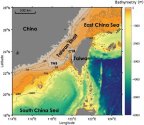An interesting appraisal of the IDS Hai Kung.
Mr Sutton basically dismissed local media reports of Japanese influence in the design, stating that it is essentially a copy of the Dutch Zwaardvis class. Does this mean technologies like lithium-ion batteries have not been used, contrary to persistent Pan Green-leaning media reports?
Anechoic coating is not currently present, and according to HI Sutton may have been skipped. No mention is made of the apparent manufacturing defects seen in some photos.
Ship architecture has no influence on the type of electric batteries used.
What he is referring to in linking the design to Zwaardvis is hull structure and functional layout of the interior which are two separate problems and which have no bearing on other design elements like batteries, motor type, sonar or combat systems.
Why is that relevant?
Submarines move in three dimension. The horizontal plane is obvious but the vertical plane is controlled by gravity which in turn is controlled by hydraulic ballast. And this creates a complication where the
submarine has to be in equilibrium both dynamically and statically at the same time no matter whether it goes down, up, left,right etc.
A surface ship uses solid ballast which can be moved mechanically to help stabilise the hull. The submarine uses water as ballast because otherwise it wouldn't be able to dive and surface. Water is obviously very difficult to move in a controlled manner, especially if due to structural stress the hull loses integrity. Then the entire space of the hull becomes a dynamic, uncontrolled ballast tank which usually ends up sinking the boat.
Submarines sink not because they're cracked open but because the stress imparted on the hull creates tiny openings which under heavy pressure force the water in. Then the sub loses equilibrium, turns vertical which means it loses the ability for controlled motion and slowly sinks to the bottom.
Submarine design is therefore a very difficult and complex task because any loss of integrity anywhere can disrupt the equilibrium of the entire hull which is fatal to the sub. So practical experience and tested hull design are essential because even with extensive computer modelling there's always a risk in material quality, production quality (welding) etc. And because a submerged boat that suffers pressure hull failure is extremely difficult to recover the priority is on risk reduction. In submarine design a better - e.g. more stealthy - hull is never superior to a safer hull.
So it is logical that a simpler hull design, especially one that Taiwan is already familiar with (Zwaardvis-derived Hai Lung was maintained in Taiwanese shipyards) would be selected for the new boat. But other than that all the other systems can be changed.
A few other observations:
Lack of anechoic tiles makes the ship more vulnerable to active sonar, not so much to passive sonar. Any diesel sub moves typically at very low speeds due to limited energy supply - even including better batteries - and thus doesn't generate too much noise. The hull itself is too traditional to have significant echo reduction qualities. Kilo was designed with tiling from the start because of its planed use in littorals.
X-shaped rudder is significant when it comes to maneuvering in the littorals and most importantly it allows the ship to lie at the bottom.
Sweden has used X-tail on all its boats since Sjoormen class in the 1960s but Baltic sea has only a single point where the depth exceeds 400m (Landsort depth in Swedish waters), th next deepest point of ~300m is in Gulf of Bothnia, also Swedish waters, and only then there's the Gotland depth of only 250m in the middle of the sea.

Sweden chose it because submarines were its primary anti-shipping weapon that would combat Soviet amphibious ships. For the same role Germany and Denmark used Type 205/206 which is a traditional design. So X-tail provides some improvement but nothing revolutionary.
It also wouldn't be much use outside of the Strait due to how quickly the depth exceeds 500-1000m. The island itself essentially sits at the edge of an undersea cliff.

Another issue is numbers.
During Cold War NATO had
29 submarines in the Baltic: 24 German, 5 Danish. All essentially sitting at the bottom in the waters along the Danish coast (because of East Germany) and around Bornholm in anticipation of WarPact amphibious assault with only a few boats venturing into WarPact waters because Baltic Fleet and Volksmarine had too many ASW assets in the area. Those 29 subs however produced high force density if placed defensively. On top of that Sweden would remain technically neutral and field at least some of its 14 (70s) or 11 (80s) submarines in the area adding complication.
Black line is a NATO defense perimeter. White line is Taiwan defensive perimeter, assuming deep waters are secured by USN+allies.

Even if
somehow all 8 boats enter service by 2035, IDS won't significantly factor in any hypothetical invasion scenario. For reference: North Korea has ~20 Romeo and ~40 Sang-O and Taiwan won't be able to resist long enough for its subs to operate from allied bases.
8x IDS makes no tactical or strategic sense. It's excessively wasteful. So why is it being built? Surely not so that Minnie Chan and H.I.Sutton can make their daily quota of reporting?



